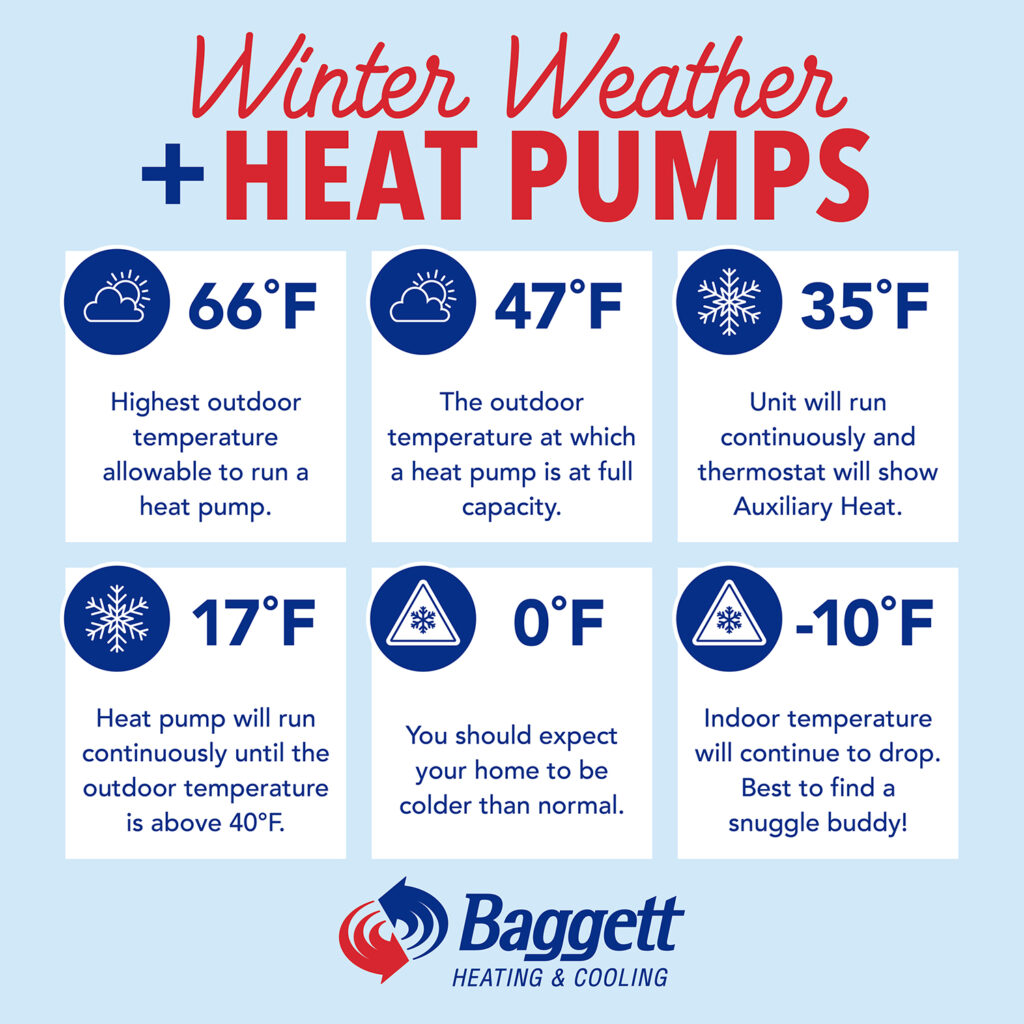With winter comes extra demand on your heat pump and questions come up like “Why is it making noise?” or “What’s the difference between auxiliary & emergency heat?”
At Baggett Heating & Cooling, we get these questions every winter. But the great news is, we have answers to ensure your home stays comfortably warm this winter.

Let’s start with a visual, shall we?…
We like using this graphic as a go-to guide for understanding how the deep freeze affects your heat pump’s efficiency. Let’s walk you through the crucial numbers that keep your comfort and your heat pump in check when the mercury plummets.
Now on to some commonly asked questions in the winter season…
What is a Heat Pump?
- Heat pumps are energy-efficient, electrically powered, HVAC systems providing heating and cooling for year-round comfort.
- Instead of creating heat, heat pumps simply transfer heat from one space to another, depending on the season.
- During the cooling season, heat pumps transfer heat out of the home, and during the heating season, they transfer heat inside your home.
- During the cooling season, heat pumps operate just like central air conditioning systems. The heat from the inside of your home is pressurized by refrigerant and transferred outside to lower the indoor temperature of your home.
- When heating your home, the process is reversed. The heat pump extracts heat from the air outside. It is pressurized and transferred through refrigerant to the inside of your home to raise the temperature to create a comfortable living environment.
What’s the difference between auxiliary and emergency heat?
- Auxiliary heat is automatically activated when there is not enough outdoor heat to warm up your home.
- Emergency heat should only be turned on in emergency situations.
- Emergency heat is a mode that you manually select if your unit is not providing any heat for a reason such as malfunction.
For more information about Auxiliary/Emergency Heat, go to our previous blog here.
When Do I Turn On Emergency Heat?
- The emergency heat should only be turned on in emergency situations:
- For example, during periods of freezing rain it’s a good idea to manually set your system to emergency heat. This will keep the outdoor fan from running and being damaged from ice that is forming on the unit. Once icing stops and temps rise above freezing you can reset your system to normal heat pump mode.
- The emergency heat setting is meant to temporarily keep your home warm while you get your heat pump repaired.
- To help prevent any malfunction during these winter months and maintain a comfortable indoor temperature, Baggett recommends regular maintenance performed on your HVAC system. Regular maintenance is best for your equipment and also it protects warranty coverage as well. Learn more about routine maintenance and join Baggett’s Maintenance Club.
- For more information about emergency heat, go here.
What’s that humming sound?
- Sometimes during normally occurring winter conditions, your heat pump will go into a defrost cycle.
- When this happens, the outdoor unit needs to defrost to remove frost from outdoor coil. This happens as the heat pump is removing heat from outside to pump inside.
- Frosting will happen with temps are around freezing and moisture exists in the outdoor air. This can happen with or without precipitation in the form or rain or snow.
- In defrost mode, the unit will cease blowing warm air into your home which may cause a humming sound.
- It is perfectly normal to hear a strange noise and see steam coming from your unit.
- To learn more about the defrost cycle and what you can do to help your unit, go to our previous blog here.
If we didn’t answer your specific question, please contact us today. We’re here to ensure your HVAC system runs smoothly year-round.
Baggett Heating & Cooling is locally owned and operated and has been serving the Clarksville-Montgomery County area for over 40 years.





